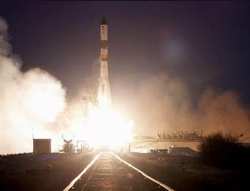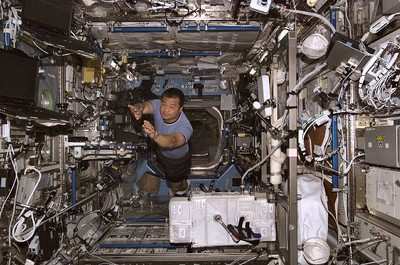With No Backup, The "Astronaut's Rule" Is In Effect
 A Russian cargo spacecraft is on its
way to the International Space Station. The Progress resupply ship
launched at 1719:31 EST from the Baikonur Cosmodrome, Kazakhstan,
and less than 10 minutes later settled into orbit. Moments after
that, automatic commands deployed its solar arrays and navigational
antennas.
A Russian cargo spacecraft is on its
way to the International Space Station. The Progress resupply ship
launched at 1719:31 EST from the Baikonur Cosmodrome, Kazakhstan,
and less than 10 minutes later settled into orbit. Moments after
that, automatic commands deployed its solar arrays and navigational
antennas.
Without a flying fleet of space shuttles, of course, there's no
backup for the Progress ship. If something goes wrong with the
docking on Christmas Day, the crew aboard the Interntational Space
Station is concerned they won't have enough supplies and may have
to abandon the ISS -- at least, temporarily.
As the Progress launched, Expedition 10 Commander and NASA
Station Science Officer Leroy Chiao and Flight Engineer Salizhan
Sharipov were a few minutes from the start of their sleep period.
The Station was flying over western Chile at an altitude of 225
statute miles at the time of lift off.
Engine firings are scheduled overnight to raise and refine the
Progress' orbit and its path to the Station for an automated
docking at 1831 p.m. EST Dec. 25. It will dock to the aft port of
the Station's Zvezda living quarters module. This will be the 16th
Progress spacecraft to dock with the Station. The Christmas Day
docking will be broadcast live on NASA Television beginning at 1730
EST.

The Progress is carrying 5,000 pounds of food, fuel, oxygen,
water, spare parts and holiday presents to the crew. It's loaded
with 1,234 pounds of propellant, 110 pounds of oxygen and air, 926
pounds of water, and more than 2,700 pounds of spare parts, life
support system components and experiment hardware. The manifest
also includes about a 112-day supply of food in 69 containers to
replenish the Station pantry. Other items on the Progress include
new laptop computers, replacement parts for the US spacesuits and
additional components for the arrival next year of the European
Automated Transfer Vehicle, another type of automated cargo
craft.
Chiao and Sharipov are scheduled to open the hatch to the
Progress shortly after 1300 EST Sunday to begin unloading the
cargo.
The Progress spacecraft that had been at the Station since
August was undocked yesterday by Russian flight controllers at 1437
EST. Filled with discarded items, it was commanded to deorbit about
four hours later and burned up in the Earth's atmosphere.
The crew also continued their science research this week. Chiao
and Sharipov conducted another in a series of tests of the Advanced
Diagnostic Ultrasound in Micro-G experiment.
On the first day, they took turns performing bone and dental
scans on each other. One day later, after six hours of fasting,
Sharipov was the subject for abdominal scans. Chiao also performed
an abdominal scan on Sharipov to recover from a previous session
during which data was lost.
They also used the Crew Medical Restraint System for positioning
the subject and electrodes for electrocardiogram recording. The
scanning and post-scan activities were videotaped and photographed
for downlinking to the ground for interpretation. The experiment
tests the diagnostic capability of ultrasound for medical
contingencies that could occur in a space environment

Later in the week, Chiao and the ground team conducted their
post-session analysis to discuss the successful ultrasound scans
and in particular the abdominal scan conducted on Salizhan.
Conducting the scans repeatedly increases the proficiency of
crewmembers.
The experiment has already demonstrated the capability of
non-medical personnel to downlink diagnostic information for
evaluation by medical specialists on the ground. This
"telemedicine" technique has application to emergency medical care
in remote areas of the earth, as well as for astronaut crews
traveling beyond low earth orbit.
 ANN's Daily Aero-Linx (04.15.24)
ANN's Daily Aero-Linx (04.15.24) Classic Aero-TV: 'No Other Options' -- The Israeli Air Force's Danny Shapira
Classic Aero-TV: 'No Other Options' -- The Israeli Air Force's Danny Shapira Aero-News: Quote of the Day (04.15.24)
Aero-News: Quote of the Day (04.15.24) Airborne 04.16.24: RV Update, Affordable Flying Expo, Diamond Lil
Airborne 04.16.24: RV Update, Affordable Flying Expo, Diamond Lil ANN's Daily Aero-Term (04.16.24): Chart Supplement US
ANN's Daily Aero-Term (04.16.24): Chart Supplement US





